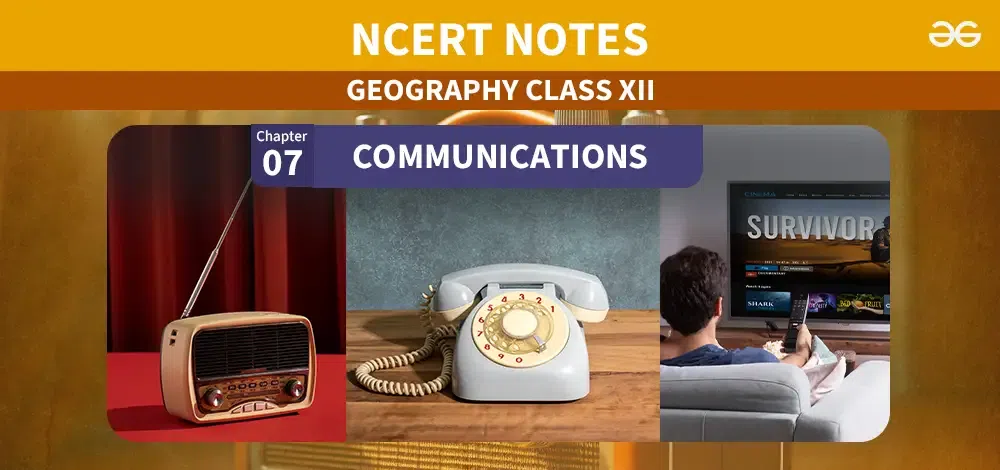Class 12 Geography Notes Chapter 7 Communications
Last Updated :
24 Apr, 2024
Communication technologies have continually evolved, shaping how individuals connect and interact across vast distances. From the pioneering days of the telegraph to the modern era of satellite communication and cyberspace, the landscape of human communication has undergone remarkable transformations.
This article explores the dynamic evolution of communication technologies, highlighting key milestones and innovations that have revolutionized how information is exchanged and relationships are forged in the contemporary world.

Class 12 Geography Notes Chapter 7 Communications
Evolution of Communication Technologies
The evolution of communication is as follows:
Telegraph and Telephone Era
The history of long-distance communication traces back to the telegraph and telephone, pivotal technologies that revolutionized connectivity. The telegraph played a crucial role in the colonization of the American West, while the American Telegraph and Telephone Company (AT&T) monopolized the telephone industry in the early to mid-twentieth century, driving urbanization in the United States.
Rise of Cellular Communication
Telephones, particularly cell phones, continue to dominate communication channels, especially in developing countries where satellite technology enables rural connectivity. The widespread adoption of cell phones underscores their accessibility and affordability, facilitated by advancements in satellite communication.
Optical Fiber Cable Revolution
The advent of optic fiber cables (OFC) marked a significant breakthrough in communication infrastructure. Telephone companies worldwide swiftly upgraded their systems to incorporate OFC, enabling rapid, secure, and error-free transmission of large data volumes. This transition paved the way for the digitization of information and the convergence of telecommunication with computer networks, giving rise to integrated systems like the Internet.
Satellite Communication
Satellite communication has emerged as a cornerstone of modern connectivity, facilitating global interaction and information exchange. Satellites play a crucial role in various aspects of daily life, including cell phone communication, SMS services, and cable television broadcasts. Since the 1970s, artificial satellites have been deployed in Earth’s orbit, connecting even the most remote corners of the globe and ensuring consistent communication regardless of distance.
India’s Satellite Endeavors
India has made significant strides in satellite development, launching satellites like Aryabhatt, Bhaskar-I, and Rohini. Initiatives such as APPLE Challenger and INSAT I-B have revolutionized long-distance communication, television broadcasting, and weather forecasting, enhancing the nation’s technological prowess and communication infrastructure.
Cyberspace and the Internet Revolution
Cyberspace, epitomized by the Internet and the World Wide Web (www), represents a digital realm where communication transcends physical boundaries. The exponential growth of the Internet has transformed human interaction, with over two billion users globally by 2010. The shift in Internet users from developed to developing countries underscores its democratizing influence, empowering individuals worldwide with access to e-mail, e-commerce, e-learning, and e-governance services.
Conclusion
The proliferation of modern communication systems, particularly the Internet, has reshaped the global landscape, transcending geographical barriers and fostering a sense of interconnectedness. These advancements have not only facilitated economic transactions but also facilitated social interactions and governance processes. In essence, modern communication technologies, more than transportation, have brought the concept of a global village to fruition, reshaping human experience and interaction in the contemporary era.
Class 12 Geography Notes Chapter 7 Communications- FAQs
What role did the telegraph and telephone play in shaping early long-distance communication?
The telegraph and telephone were instrumental in revolutionizing long-distance communication, facilitating rapid transmission of messages and enabling real-time conversations across vast distances. These technologies played pivotal roles in historical events, such as the colonization of the American West and the urbanization of America.
How has satellite communication transformed connectivity on a global scale?
Satellite communication has revolutionized connectivity by bridging geographical barriers and ensuring consistent communication even in remote areas. Satellites enable various services, including cell phone communication, SMS messaging, and television broadcasts, making them indispensable components of modern communication infrastructure.
What are the advantages of optical fiber cables (OFC) over traditional copper cables?
Optical fiber cables (OFC) offer several advantages over traditional copper cables, including higher transmission speeds, enhanced security, and minimal signal loss. The adoption of OFC by telephone companies worldwide has facilitated the rapid and error-free transmission of large data volumes, contributing to the digitization of information and the emergence of integrated networks like the Internet.
How has India contributed to satellite technology and space research?
India has made significant strides in satellite development and space research, launching satellites like Aryabhatt, Bhaskar-I, and Rohini. Initiatives such as the APPLE Challenger and INSAT I-B have revolutionized long-distance communication, television broadcasting, and weather forecasting, showcasing India’s technological prowess and advancements in communication infrastructure.
What impact has the Internet had on global communication and societal interactions?
The Internet has transformed global communication by providing individuals worldwide with access to e-mail, e-commerce, e-learning, and e-governance services. With over two billion users globally, the Internet has reshaped social interactions, governance processes, and economic transactions, fostering a sense of interconnectedness and bringing the concept of a global village to fruition.
Share your thoughts in the comments
Please Login to comment...